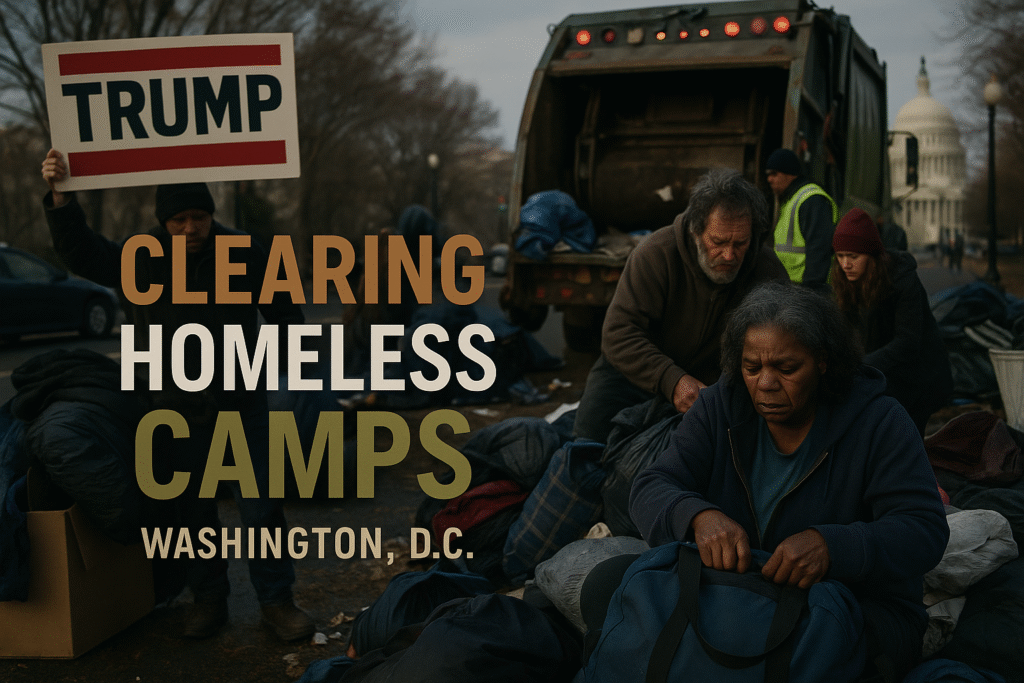

DC Homeless Clearings Spark Debate
By Darius Spearman (africanelements)
Support African Elements at patreon.com/africanelements and hear recent news in a single playlist. Additionally, you can gain early access to ad-free video content.
Homeless Encampment Clearings
Washington D.C. authorities have started a controversial policing effort to clear homeless encampments. This action has drawn criticism from advocates who say it targets vulnerable individuals without offering lasting solutions. On August 15, 2025, homeless residents near the Institute of Peace in Washington D.C. were seen packing their belongings. A garbage truck waited nearby to remove abandoned items (euronews.com). Volunteers from local aid agencies were present to offer assistance. Protesters with anti-Trump signs also gathered nearby. Officials cordoned off the area to give residents time to clear their possessions (euronews.com).
The District of Columbia regularly conducts encampment clearings. Over 50 encampments have been cleared so far in 2025 (streetsensemedia.org). On federal land in the District, camping is also illegal. The U.S. Park Police have arrested people for camping in the past (streetsensemedia.org). Before President Trump’s press conference, these regularly scheduled clearings happened as planned on July 23 and August 6 (streetsensemedia.org). The recent federal takeover of the Metropolitan Police Department (MPD) by the Trump administration has intensified these efforts. Encampment clearings began shortly after the order. However, the exact criteria for these clearings, beyond general safety concerns, and the balance between enforcement and support services remain largely undefined in the available information.
Controversial Policing Push
The move to clear homeless camps is part of a broader policing push in Washington D.C. Some sources link this push to President Trump's concerns about crime in the city. President Trump has stated that crime in Washington D.C. is “out of control.” He cited a recent serious attack on a former government efficiency staff member (baohaiphong.vn). The “controversial policing push” refers to the Trump administration's directive to clear homeless encampments in Washington D.C., especially after the federal takeover of the Metropolitan Police Department (MPD).
This approach is controversial because it prioritizes clearing encampments over addressing the root causes of homelessness. Critics argue that it is a “tough-on-crime” agenda that lacks sustainable solutions. It primarily aims to remove visible homelessness without providing adequate support or housing (seattletimes.com). The controversy comes from the perceived lack of comprehensive solutions and the potential for displacement without effective alternatives (nbcwashington.com). Washington’s status as a congressionally established federal district gives President Trump the chance to push his tough-on-crime agenda. However, he has not proposed solutions to the root causes of homelessness or crime (seattletimes.com).
Crime Data and Trends
Despite President Trump's claims, data shows that violent crime in Washington D.C. has actually decreased in recent years (baohaiphong.vn). After a significant increase in 2023, violent crime in D.C. has been steadily declining (baohaiphong.vn). The latest data from the Metropolitan Police Department (MPD) shows that year-to-date violent crime has decreased by 26% compared to the same period in 2024. This is its lowest level in at least six years, even lower than during the end of President Trump's first term (baohaiphong.vn).
The presence of anti-Trump protesters near the clearing site highlights the political and social opposition to the administration's policies, including the encampment clearings (washingtonpost.com). The broader context suggests that the protests are likely linked to the Trump administration's “tough-on-crime” agenda and its approach to homelessness, which some view as punitive rather than supportive. This ongoing debate about crime statistics and the approach to homelessness underscores the complex challenges facing Washington D.C.
Violent Crime Trends in Washington D.C.
Economic Policies and Funding
The broader political landscape in Washington D.C. includes discussions on economic policies and potential legal settlements that could impact federal funding. A recent law is estimated to cost low-income households approximately $1,200 per year. In contrast, wealthier households are projected to benefit by over $13,000 annually (kiowacountypress.net). This disparity in economic impact raises questions about the fairness and equity of current policies. It also highlights how economic decisions can disproportionately affect different segments of the population, including those experiencing homelessness.
The Trump administration and Harvard University are reportedly close to a legal settlement. This settlement could restore billions of dollars in federal research grants (kiowacountypress.net). While the direct connection of this settlement to homelessness or policing efforts is not explicitly stated, it points to significant financial movements within the federal system. Such large-scale financial agreements can influence the overall economic climate and the allocation of resources, which in turn may indirectly affect social programs and services aimed at addressing homelessness.
Alternatives to Clearing Camps
The current approach to homelessness in Washington D.C., heavily focused on encampment clearings, raises questions about sustainable solutions. Advocates express concern that the current strategy does not address the root causes of homelessness. They argue that better ways exist to tackle the issue than simply clearing encampments (seattletimes.com). The broader strategy to address homelessness, beyond enforcement, is not detailed in the available information. This leaves a gap in understanding what long-term solutions are being considered or implemented to help individuals transition out of homelessness.
The lack of clear information on alternatives is a significant concern for many. It suggests a focus on visible removal rather than comprehensive support. Without addressing underlying issues such as affordable housing, mental health services, and job opportunities, individuals displaced from encampments may simply move to other areas. This creates a cycle of displacement rather than providing lasting stability. The debate continues about whether the current policing push is a temporary measure or part of a longer-term strategy, and what future plans or evaluations are in place.
Understanding Homelessness Terminology
The process by which authorities remove homeless individuals and their belongings from public spaces, often involving law enforcement and sanitation services.
An annual count of sheltered and unsheltered homeless persons on a single night in January, conducted by municipal agencies across the United States.
Homeless Population Data
Understanding the scale of homelessness in Washington D.C. is crucial to assessing the impact of the policing push. It is difficult to obtain accurate counts of homeless populations (seattletimes.com). On one day at the end of each January, municipal agencies across the United States perform what is called a “point-in-time” count. This count aims to capture the total number of people in emergency shelters, transitional housing, or without any housing (seattletimes.com). While this count provides a snapshot, specific statistical data on the size, demographics, or trends of the homeless population in Washington D.C. is not provided in the available information. This lack of detailed data makes it challenging to fully grasp the scope and impact of the clearings on the affected individuals.
The absence of comprehensive demographic data also means that the specific impact on African American or African Diaspora individuals within the homeless population is not clearly outlined. Given the historical and ongoing disparities faced by Black communities in housing and economic stability, understanding these demographics would provide a more nuanced picture of how these policies affect different groups. Without this information, it is harder to advocate for targeted solutions that address the unique challenges faced by these communities.
Health and Safety Risks
Safety concerns are mentioned as a trigger for clearing camps. However, the available information does not specify what health or safety risks are involved. It also does not explain how these risks are assessed or mitigated. This lack of detail leaves questions about the specific dangers that prompt these clearings. It also raises concerns about whether the clearings genuinely improve health and safety for the homeless individuals or the broader community.
Furthermore, the impact of clearing homeless camps on the surrounding community, including residents and businesses, is not discussed. This leaves a gap in understanding the broader social context and potential ripple effects. Similarly, there is no information on what happens to displaced individuals after camps are cleared. It is unclear whether they receive housing, services, or are simply displaced elsewhere. This absence of post-clearing outcomes makes it difficult to evaluate the effectiveness and humanitarian impact of these operations. It also prevents a full understanding of the public sentiment or feedback from various stakeholders, including homeless individuals, advocates, residents, and law enforcement.
Key Events in D.C. Policing and Homelessness
-
Early 2023
Violent crime in D.C. sees a significant increase.
-
July 23, 2025
Regularly scheduled encampment clearings proceed as planned.
-
August 6, 2025
Regularly scheduled encampment clearings proceed as planned.
-
August 11, 2025
Discussions on economic policies and potential legal settlements impacting federal funding, including a law costing low-income households $1,200 annually, are ongoing.
-
August 15, 2025
Homeless encampments near the Institute of Peace are cleared as part of a controversial policing push.
-
Year-to-Date 2025
Over 50 encampments cleared; violent crime decreases by 26% compared to 2024.
ABOUT THE AUTHOR
Darius Spearman has been a professor of Black Studies at San Diego City College since 2007. He is the author of several books, including Between The Color Lines: A History of African Americans on the California Frontier Through 1890. You can visit Darius online at africanelements.org.
